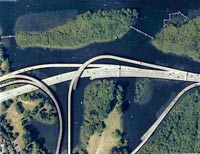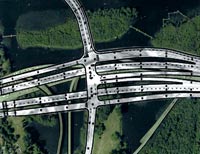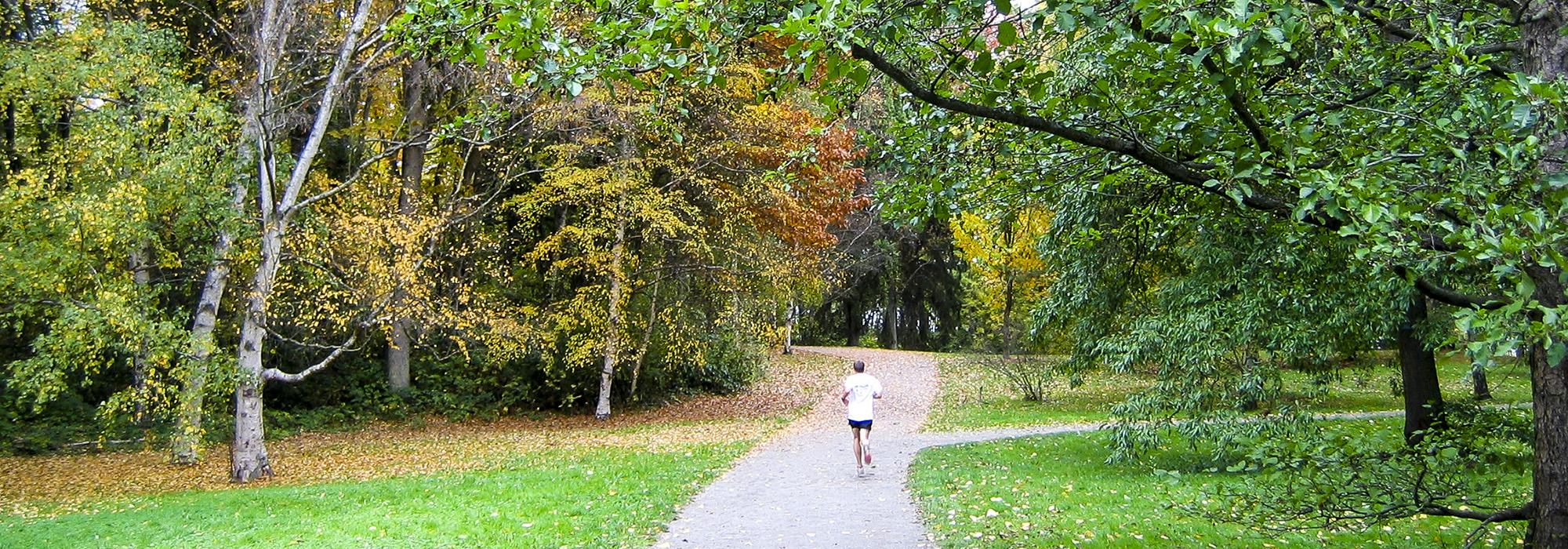A Threatened Olmsted Legacy in Seattle
Planned freeway construction is once again threatening one of Seattle's most culturally important landscapes. The Arboretum that is not only a civic treasure, but an astounding horticultural resource for the entire region.
These current plans are not the first time that the Olmsted-designed landscape has been threatened. In 1969, thousands of citizens marched in the Washington Park Arboretum protesting the building of the R.H. Thomson Expressway, outraged by the damage that was underway. Without these concerned citizens and their concerted actions, highway construction would have transferred significant swaths of park property over to transportation uses, marring not only the park, but the entire linked system of Olmsted spaces. Fortunately, the marches and protests through the Arboretum were successful in turning back the tidal surge of transportation projects.
Yet highway construction had already impacted the Arboretum earlier in the same decade. In 1963, the state completed the Evergreen Point Floating Bridge to create an east/west traffic corridor along route 520 directly through the Arboretum's northern wetlands, which are among the only wetlands remaining in Seattle .
Rather than learning from unfortunate past mistakes, today's state and local officials are once again making machinations for a massive expansion of the deteriorating bridge. One option even proposes a de facto R.H. Thomson Expressway north/south along Lake Washington Boulevard , undoing the courageous work of citizens from a generation ago.
History
What distinguishes the Olmsted Brothers practice in Seattle is the seminal and extensive use of the "borrowed landscape." John Charles Olmsted developed Seattle 's park system primarily along the edges of the city's waterways, giving residents the pleasure of experiencing an expansive regional view, even while sitting in a budding metropolis. Toward this end, Olmsted 's 1903 Master Plan established a 20-mile-long linked system of parks along the scenic edge of Lake Washington that opened up the city to an incredible vista of the Cascade range, crowned by the towering white dome of Mount Rainier . Beginning at Seward Park , this pleasure drive follows the curves of the lake, past Mount Baker Park , Frink Park , Colman Park and Madrona Park , continuing through Washington Park , which today encompasses the Arboretum. This Olmstedian "green ring " defines Seattle 's public landscapes.
"Seattle possesses extraordinary landscape advantages in having a great abundance and variety of water views and views of wooded hills and distant mountains and snow-capped peaks. I do not know of any place where the natural advantages for parks are better than here. They can be made very attractive and will be, in time, one of the things that will make Seattle known all over the world."
-- John Olmsted , May 1, 1903 , Seattle Post-Intelligencer
The Arboretum was originally conceived in tandem with the founding of the University of Washington , also an Olmsted-designed landscape. In 1891, when UW President Edmund Meany introduced legislation to acquire the campus, one colleague was quoted as saying, "I want to vote for your bill, Meany, but tell me: what the hell is an arboretum?" At times, it seems that elected officials still don't know what an arboretum represents, particularly in an urban context. The mold for the Washington Park Arboretum was cast at Harvard University 's Arnold Arboretum, and, like its East Coast progenitor, the Washington Park Arboretum is a world-class, living collection of hardy, woody plants collected and maintained for purposes of education, conservation, research and public inspiration.
In 1936, the Washington Park Arboretum planting scheme became the final Olmsted Brothers design implemented in Seattle . Located in a moist, maritime environment that allows for the cultivation of a greater range of plants than any other region in North America , the Arboretum is a botanical treasure trove located in the heart of the region's largest metropolitan region. With over 4,800 species and cultivated varieties on its grounds this 230-acre park has a plant collection of international significance and acclaim.
The cultural value of the arboretum extends back far further than the Olmsted interventions. Since before white settlers arrived, the Duwamish tribe has used Foster Island as a burial ground and sacred space. (Unfortunately, this story is minimized in existing documentation, including the current draft environmental impact statement [DEIS]).
"We will ponder your proposition [to sell our land and be moved to a reservation],.. I here and now make this the first condition: That we will not be denied the privilege, without molestation, of visiting at will the graves of our ancestors and friends. Every part of this country is sacred to my people. Every hill-side, every valley, every plain and grove has been hallowed.., for the soil is rich with the life of our kindred." - Chief Si'ahl , namesake of the City of Seattle and Duwamish chief
 |
 |
 |
Existing roadway (left) and Proposed (middle). Historic view of an Olmsted designed bridge
Management
Today, a trio of organizations manages the Arboretum. The City of Seattle owns and maintains the land and the park's 1960 Japanese Garden ; the University of Washington manages the plant collections; and the Arboretum Foundation provides funding and educational programs. These three organizations have collaborated to prepare a Master Plan (2001) for renewal of the Arboretum, and a capital-campaign is currently underway to implement that plan.
Wetlands In The City
The importance of the Arboretum is not just cultural; it is also an ecological and recreational treasure. Along the northern edge of the park rests Seattle's largest remaining lacustrine wetlands. An enormously popular waterfront trail connects the mainland to Marsh and Foster Islands bringing thousands of visitors to the park throughout the year. The resilience of this natural setting is astonishing. Even with a 4-lane highway traveling straight through its heart, the quietude and serenity that one can find in this space is inspirational.
From an ecological perspective, these wetlands are a fecund remnant of the once-abundant ecological systems that ringed the lake. This rare forested wetland hosts an astonishing variety of species; eagles, hawks, turtles, migratory and native waterfowl, native and ornamental tree species, indigenous wetland reeds, grasses and fauna.
The Arboretum or The Arbor On-Ramp
The freeway interchange that funnels cars onto the historic pleasure drive, Lake Washington Boulevard, was originally built for the voter-rejected R.H. Thomson Expressway. Now connecting only to Lake Washington Boulevard , this interchange has turned the Arboretum into a scenic commuter corridor with a disproportionate traffic load, as drivers shortcut through the park to get onto the highway. The latest traffic studies show the 2-lane Boulevard averaging 19,000 cars per day, while the nearby 4-lane arterial 23rd Avenue East averages just 18,700 cars per day. Already, daily congestion causes thousands of cars to idle in the Arboretum, spewing exhaust into the plant collections thus damaging sometime irreplaceable specimens.
The Threat
A freeway bisecting an Arboretum is a physical manifestation of our culture's priorities. While few debate the necessity of replacing a bridge that is vulnerable to earthquakes and windstorms, the magnitude of the replacement needs to be carefully considered. To bring a new bridge up to code, and to accommodate new bike lanes, a new 4-lane bridge will already take up twice as much space as it does today. However, this pales in comparison to other options that are on the table. The 6-lane option expands the bridge up to four times its current width, yet has little appreciable difference in commute times.
The lead agency drafting the environmental impact statement is Washington State Department of Transportation (WSDOT). WSDOT fails to analyze future traffic patterns on Lake Washington Boulevard's "green ring" because this would trigger compliance with two critical pieces of legislation; Section 106 of the Historic Preservation Act and Section 4(f) of the Transportation Act. Both explicitly prohibit such an action.
The failure to comply with national regulations is opaque. All alternatives in the draft environmental impact statement move freeway infrastructure away from urban development and into park land. All alternatives keep the ramps open onto the 2-lane Lake Washington Boulevard , while removing the interchange at the nearby 4-lane arterial. All alternatives plan to use historic park land as a construction staging zone, and all alternatives plan to build a "temporary bridge" parallel to the existing bridge on Arboretum land. The most politically popular alternative is also the most damaging. The "Pacific Interchange" would be fifteen lanes wide, with two stop-lights placed 70 feet in the air. Directly adjacent would be an additional, new transom bridge that would cross directly over Marsh Island and be visible throughout the Arboretum.
How to Help
Please consider sending email to the contacts below, and including the following statement:
I request that a thorough Section 106 review be undertaken of the effects of the SR 520 Project on Washington Park Arboretum, Lake Washington Boulevard and University of Washington Campus. All are significant Olmsted cultural landscapes, all are eligible for listing on the National Register of Historic Places, and all are adversely impacted by all proposed 520 alternatives. Furthermore, please authorize the necessary funding to fully study options that eliminate all ramps to Lake Washington Boulevard in the Arboretum. Please minimize impacts by replacing the bridge with the 4-lane, transit-prioritized option such as the Green Alternative, or by tunneling, lidding and/or realigning SR520. This is an issue of national importance.
Send comments to:
Governor Gregoire 's aide Jennifer Ziegler - jennifer.ziegler@gov.wa.gov ,
Deputy Mayor Tim Cies - tim.ceis@seattle.gov
Seattle City Councilmember Nick Licata -



